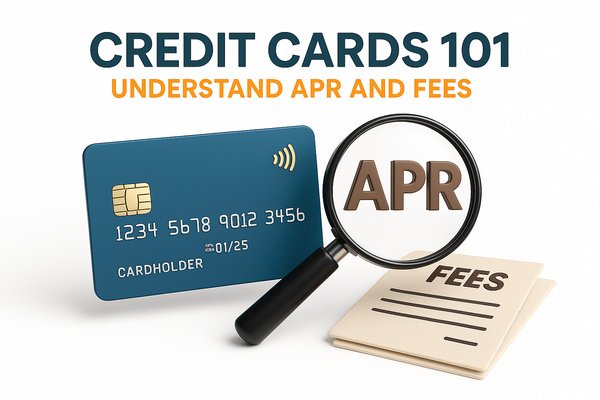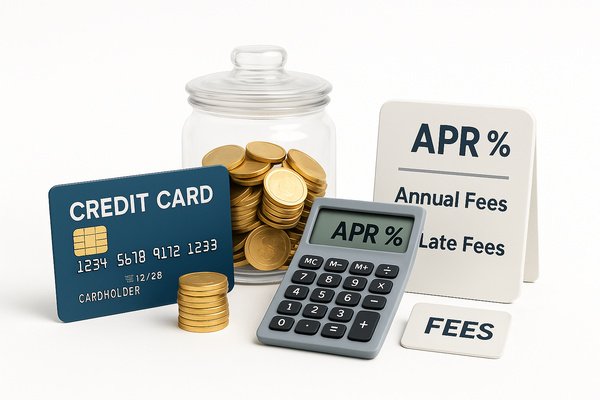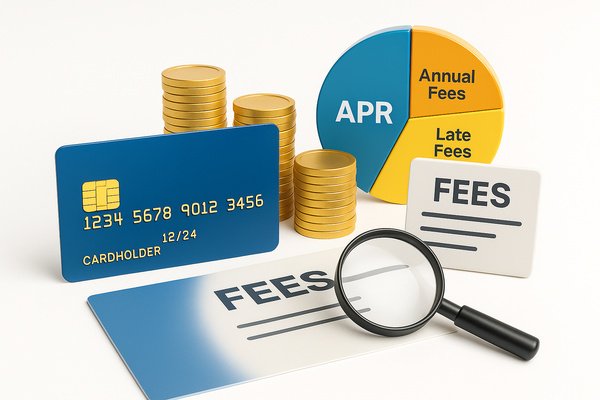Credit Cards 101: Understanding APR and Fees
In today’s financial world, having a credit card is almost as essential as having a smartphone. But if you don’t fully understand how they work, you could end up paying far more than you bargained for. That’s why learning Credit Cards 101: Understanding APR and Fees is one of the smartest financial moves you can make this year.
Millions of consumers use credit cards daily, yet most people don’t truly understand how interest is calculated, what fees apply, or how those details can impact their credit and overall finances. Whether you’re getting your first card, rebuilding your credit, or just want to become a smarter borrower, this guide will break down everything you need to know.
The truth is, credit cards are powerful tools when used wisely, but they can quickly become traps if misunderstood. Learning Credit Cards 101: Understanding APR and Fees helps you navigate terms that credit card companies use to make money off the uninformed. APR (Annual Percentage Rate), balance transfers, late payment fees, and penalty APRs, these aren’t just fine print. They’re the keys to managing your card like a pro.
Throughout this article, we’ll explore the different types of APR, how fees are structured, and practical ways to avoid costly mistakes. Each section is designed to help you take control of your finances and use credit cards to your advantage, not the other way around.
So if you’ve ever wondered why your balance keeps growing even when you make payments, or why that 0% offer turned into a nightmare, buckle up. This is your crash course in Credit Cards 101: Understanding APR and Fees is designed to empower you with the knowledge most cardholders wish they had sooner.
What Is APR and Why It Matters
At the heart of Credit Cards 101: Understanding APR and Fees is the concept of APR, or Annual Percentage Rate. This number determines how much interest you’ll pay if you carry a balance on your credit card, and it can vary more than most people realize.
APR is not just a number printed on your statement. It reflects the true cost of borrowing. Think of it like rent on the money you’ve borrowed. If your APR is 20%, and you carry a $1,000 balance for a year, you’ll owe roughly $200 in interest on top of the original debt.
But here’s the catch: APR is not always a fixed number. Most credit cards have variable APRs, which means they’re tied to an index like the U.S. Prime Rate. As the economy changes, your interest rate can rise even if you make payments on time.
There are also different types of APRs:
Each of these plays a role in Credit Cards 101: Understanding APR and Fees, because many people don’t realize they can have more than one APR at the same time. For example, a single card might charge 18% on purchases, 25% on cash advances, and 29.99% as a penalty rate.
Knowing your APR empowers you to make smarter choices. If you’re planning a large purchase and don’t expect to pay it off right away, choosing a card with a lower APR can save you hundreds in interest.
Ultimately, Credit Cards 101: Understanding APR and Fees means knowing how and when APR affects your wallet. The more you understand it, the better your chances of staying ahead and saving money over the long term.
How Interest Is Calculated on Your Balance
Understanding how interest is calculated is a crucial part of Credit Cards 101: Understanding APR and Fees. Many cardholders assume that interest is charged once a month in one lump sum, but that’s not how it works. In reality, most credit card issuers use daily compounding interest, which means your balance is growing every single day you carry it.
Let’s break it down: the APR is annual, but interest is typically calculated using a daily periodic rate. To find this, the credit card company divides your APR by 365. For example, if your APR is 20%, your daily rate is approximately 0.055%.
Now, each day, your issuer multiplies that rate by your average daily balance. And here’s where it gets tricky: if you’re not paying off your card in full each month, that balance grows not only from purchases, but from interest added the day before.
That’s why carrying a balance can become so expensive, so fast.
Let’s say your average daily balance is $2,000 and your APR is 20%. You’ll be charged around $1.10 in interest each day. Over a 30-day period, that’s roughly $33 just in interest. And if you’re only making the minimum payment, most of your money is going toward interest, not reducing the actual debt.
Another key factor in Credit Cards 101: Understanding APR and Fees is your grace period. If you pay your statement balance in full and on time every month, you typically won’t pay any interest on new purchases. But once you carry a balance, the grace period vanishes and every new charge starts accumulating interest immediately.
This is why understanding how interest is calculated isn’t just about numbers, it’s about behavior. Knowing when interest starts and how it grows can help you make smarter payment decisions.
In short, Credit Cards 101: Understanding APR and Fees teaches you that avoiding interest isn’t just about luck; it’s about timing, consistency, and understanding how your credit card really works behind the scenes.
The Most Common Credit Card Fees (and How to Avoid Them)
Another essential lesson in Credit Cards 101: Understanding APR and Fees is learning about the hidden charges that can quietly drain your wallet. Beyond interest, credit card companies make billions each year from fees; many of which are completely avoidable if you know what to look for.
Here are the most common credit card fees and how to steer clear of them:
Annual Fees
Some cards, especially rewards or travel cards charge a yearly fee, ranging from $25 to $500 or more. While these cards often come with perks, they’re only worth it if you’re using the benefits. If not, switch to a no-annual-fee card to save money.
Late Payment Fees
Miss a due date, and you could be charged up to $40 in late fees. Worse, your APR might spike to a penalty APR of 29.99% or higher. Set up autopay or calendar reminders to avoid this costly mistake. One of the key takeaways from Credit Cards 101: Understanding APR and Fees is that punctuality protects your credit and your cash
Balance Transfer Fees
Transferring a balance to a card with a 0% intro APR can be a smart move, but many issuers charge 3% to 5% of the total amount transferred. Always do the math before transferring. If the savings outweigh the fee, go for it. If not, reconsider.
Cash Advance Fees
Using your card to withdraw cash comes with hefty fees and sky-high interest; often with no grace period. Avoid cash advances unless it’s a true emergency.
Foreign Transaction Fees
When traveling abroad, some cards charge up to 3% on every international purchase. Use cards with no foreign transaction fees to avoid unnecessary costs.
The key lesson from Credit Cards 101: Understanding APR and Fees is that fees are often hidden in the fine print. But with awareness, you can dodge most of them.
Bottom line? Read the terms, use your card intentionally, and you’ll avoid falling into the fee trap.
Introductory Offers vs. Long-Term Costs
One of the most attractive features you’ll see when shopping for a new credit card is the promise of introductory offers, like 0% APR for 12 to 18 months, sign-up bonuses, or no fees for the first year. While these can be valuable, one of the core lessons in Credit Cards 101: Understanding APR and Fees is to look beyond the initial perks and examine the long-term impact.
Introductory APR offers can be fantastic for short-term goals, such as paying off a large purchase or consolidating existing credit card debt. During the intro period, you can make payments interest-free, which means every dollar goes toward reducing your principal.
But here’s the fine print most people overlook: once the intro period ends, your APR will jump significantly, often to 18%, 22%, or even higher. If you haven’t paid off the balance, interest begins accumulating immediately on the remaining amount. This can wipe out the benefit of the intro offer.
Know What Triggers Penalty APRs
Many people don’t realize that even during an intro offer, missing a payment or exceeding your limit can void your promotional rate. That’s why Credit Cards 101: Understanding APR and Fees stresses the importance of consistent, on-time payments, not just for your credit score but also to keep your promotional benefits intact.
Watch for Deferred Interest
Some retail cards offer 0% “if paid in full” deals. These may sound like standard intro APR offers, but they’re actually deferred interest plans. If you miss a payment or don’t pay the full balance by the end of the period, you’ll owe back interest on the entire original amount, not just the leftover balance. That’s a financial trap you’ll want to avoid.
The Long-Term View
Introductory offers are helpful tools, but only if you plan for what comes next. Choose cards with reasonable ongoing APRs, low fees, and benefits that continue long after the intro perks expire.
In Credit Cards 101: Understanding APR and Fees, the key takeaway is this: the smartest borrowers don’t chase perks, they plan ahead. Look at the full cost over time, not just the first few months.
Introductory Offers vs. Long-Term Costs
One of the most attractive features you’ll see when shopping for a new credit card is the promise of introductory offers, like 0% APR for 12 to 18 months, sign-up bonuses, or no fees for the first year. While these can be valuable, one of the core lessons in Credit Cards 101: Understanding APR and Fees is to look beyond the initial perks and examine the long-term impact.
Introductory APR offers can be fantastic for short-term goals, such as paying off a large purchase or consolidating existing credit card debt. During the intro period, you can make payments interest-free, which means every dollar goes toward reducing your principal.
But here’s the fine print most people overlook: once the intro period ends, your APR will jump significantly, often to 18%, 22%, or even higher. If you haven’t paid off the balance, interest begins accumulating immediately on the remaining amount. This can wipe out the benefit of the intro offer.
Know What Triggers Penalty APRs
Many people don’t realize that even during an intro offer, missing a payment or exceeding your limit can void your promotional rate. That’s why Credit Cards 101: Understanding APR and Fees stresses the importance of consistent, on-time payments, not just for your credit score but also to keep your promotional benefits intact.
Watch for Deferred Interest
Some retail cards offer 0% “if paid in full” deals. These may sound like standard intro APR offers, but they’re actually deferred interest plans. If you miss a payment or don’t pay the full balance by the end of the period, you’ll owe back interest on the entire original amount, not just the leftover balance. That’s a financial trap you’ll want to avoid.
The Long-Term View
Introductory offers are helpful tools, but only if you plan for what comes next. Choose cards with reasonable ongoing APRs, low fees, and benefits that continue long after the intro perks expire.
In Credit Cards 101: Understanding APR and Fees, the key takeaway is this: the smartest borrowers don’t chase perks, they plan ahead. Look at the full cost over time, not just the first few months.
The Truth About Minimum Payments and Compound Interest
If you’ve ever wondered why your credit card balance seems to barely move, even when you’re making payments; it’s time to uncover one of the most crucial lessons in Credit Cards 101: Understanding APR and Fees: how minimum payments and compound interest really work.
What Happens When You Only Pay the Minimum?
Most credit cards require you to pay just 1% to 3% of your balance each month. While this might feel manageable, it’s actually a financial trap. That’s because the rest of your balance continues to accrue interest daily, and only a small portion of your payment goes toward the principal.
Let’s break it down:
If you have a $5,000 balance with a 20% APR and you pay just the minimum (say, $100/month), it could take you over 25 years to pay off, and you might end up paying more than $10,000 in interest. That’s the compounding effect working against you.
How Compound Interest Works Against You
Compound interest means interest is calculated not only on the original amount you borrowed but also on any unpaid interest that builds up. When applied daily (as most credit cards do), your debt grows quickly if you’re not paying it down aggressively.
That’s why Credit Cards 101: Understanding APR and Fees stresses the importance of paying more than the minimum. Even adding an extra $20–$50 a month can significantly reduce your total interest and repayment time.
How to Fight Back
Understanding how minimum payments and compound interest interact is one of the most powerful tools in your financial arsenal. When you truly grasp the mechanics, thanks to Credit Cards 101: Understanding APR and Fees, you can start using them to your advantage, not your detriment.
Best Practices for Managing Multiple Credit Cards
If you’re like most consumers, you probably have more than one credit card. While that’s not inherently a problem, juggling multiple cards can become overwhelming without the right systems in place. That’s why Credit Cards 101: Understanding APR and Fees includes essential best practices to help you stay in control of your accounts, balances, and payment schedules.
Keep Track of Due Dates
Missing a payment on even one card can tank your credit score and trigger a penalty APR, often as high as 29.99%. When managing multiple cards, it’s crucial to:
Many people fall into debt traps not because they can’t afford payments, but because they forget when those payments are due.
Assign a Purpose to Each Card
A key tip in Credit Cards 101: Understanding APR and Fees is to treat each card strategically:
By assigning roles to your cards, you reduce the risk of overcharging and improve tracking for budgeting purposes.
Avoid Overlapping Rewards Programs
It’s tempting to chase points and perks, but having too many similar rewards cards can spread your spending thin. Instead, choose 1–2 high-value rewards programs and concentrate your spending there. This maximizes points without adding complexity.
Watch Your Credit Utilization Across All Cards
Even if you stay under 30% on each card, your total utilization still matters. Lenders view the big picture. Keep your aggregate credit use low, ideally under 10%, to show strong financial discipline.
Know When to Close or Keep Accounts
Closing old or unused cards can lower your credit age and raise your utilization ratio. Unless a card has a high annual fee and no value, it’s usually better to keep it open to maintain a longer credit history.
Managing multiple credit cards can be a sign of credit savvy, not chaos. But only if you apply structure, consistency, and the principles found in Credit Cards 101: Understanding APR and Fees.
Final Thoughts: Mastering Credit Cards 101 for Long-Term Financial Success
If you’ve made it this far, congratulations, you now have a solid foundation in Credit Cards 101: Understanding APR and Fees. Credit cards are not just pieces of plastic; they are powerful financial tools that, when used wisely, can improve your credit score, earn valuable rewards, and even act as a short-term safety net. But without proper understanding, they can also spiral into high-interest debt and long-term financial stress.
Let’s recap the core lessons:
Ultimately, learning Credit Cards 101: Understanding APR and Fees is about empowerment. It’s about gaining control over your financial life and using credit as a stepping stone, not a stumbling block. You don’t have to be a financial expert to avoid debt traps, you just need awareness, strategy, and consistency.
The more confident and informed you become, the less likely you are to fall victim to high-interest rates, hidden fees, or credit score setbacks. Instead, you’ll use credit cards to build wealth, not barriers.
So whether you’re a college student opening your first account or a seasoned adult looking to clean up your credit report, applying the principles of Credit Cards 101: Understanding APR and Fees puts you in the driver’s seat of your financial future.







